Praise be! Mormons’ second coming is a blasphemous delight
By Cassie Tongue, James Jennings, John Shand and Joyce Morgan
THEATRE
THE BOOK OF MORMON
Capitol Theatre, July 24
Until December 31
Reviewed by JOYCE MORGAN
★★★★
Assume the missionary position – it’s the Mormons’ second coming.
Holey-moley, the return of this all-singing, all-dancing musical about naive young Mormon missionaries attempting to save souls in Africa is puerile and potty-mouthed, offensive, witty and satirical. And yet it’s surprisingly joyful.
It is easy to make fun of this conservative all-American religion, replete with golden plates and sacred underwear. But the tone of the musical is more affectionate than sneering.
Created by South Park’s Trey Parker and Matt Stone and Avenue Q’s Robert Lopez, this is a slightly tweaked version of the production that debuted in the US in 2011 and in Australia in 2017.
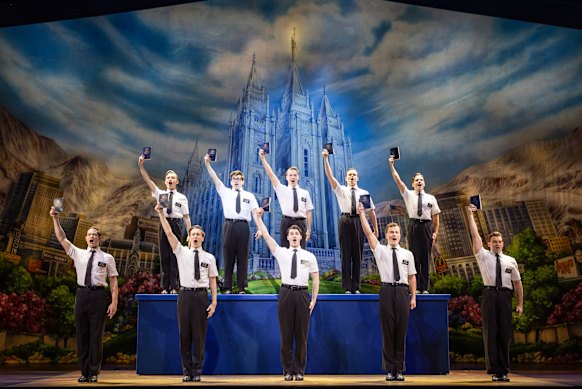
The ensemble of fresh-faced missionaries sing, dance and doorknock their way around the stage.Credit: Daniel Boud
The musical, which faced criticism that its depiction of Africans was racist, was revised after calls from black cast members following the murder of George Floyd in 2020. The changes were designed to give more agency to the Ugandan characters.
From its cracking opening number, Hello!, the show sets a high musical and choreographic bar as the ensemble of fresh-faced missionaries – all crisp white shirts and matching teeth – sing, dance and doorknock their way around the stage.
Among them are narcissistic Elder Price, who dreams of a mission to Orlando, and gormless sidekick Elder Cunningham, who simply wants to fit in. The pair is swiftly dispatched to Uganda.
There, amid an AIDS epidemic, gun-toting warlords and genital mutilation, they quickly realise they’re not in Salt Lake City any more, Toto.
This is essentially a fish-out-of-water tale, but one replete with a blond Jesus, a General Butt F---ing Naked and an overworked gag about maggots in the scrotum.
The production is musically strong, and the choreography by Casey Nicholaw (who also co-directs with Parker) is tight and extremely funny.
Highlights include Man Up; Spooky Mormon Hell Dream, Joseph Smith American Moses – as the Ugandans perform their version of the Mormon story – and the stirring I Am Africa.
This revival is finely cast, including in the two leads. Nick Cox as Elder Cunningham has a Rowan Atkinson-like awkwardness and superb comic timing as he converts the villagers with his wildly idiosyncratic version of his faith. Sean Johnston as cocksure Elder Price gets the smugness knocked out of him.
Paris Leveque made a strong professional debut as villager Nabulungi, whose character is stronger after the rewrite. Leveque demonstrated a mix of vocal sweetness and strength, as well as the fury to dispatch the warlord.
Tom Struik was hilarious as the closeted Elder McKinley, especially in the song of sexual repression Turn It Off.
Augie Tchantcho brought blustery menace to the gun-toting warlord who terrorises the village.
The Book of Mormon is the third big-budget musical to return to Sydney in as many months. It is certainly the funniest, even if, inevitably, it doesn’t have the shock value of first time around.
It pays homage to the Broadway musical, with nods to such works as The Sound of Music and The King and I among others. It does so with hand on heart and tongue in cheek.
Mozart’s Clarinet
Musica Viva
City Recital Hall, July 28.
Reviewed by PETER McCALLUM
★★★★
Clarinettist Nicola Boud, cellist Simon Cobcroft and forte-pianist Erin Helyard played Mozart and early Beethoven with transparency, style and musicality, using period instruments and unmannered ornamentation to reimagine the music as the composers themselves might have heard it.
And despite his later deafness, Beethoven did actually hear and play the latest work by him on the program, the Sonata for Fortepiano and Horn, Opus 17 (1800) transcribed for basset horn (a baritone clarinet) by his associate Joseph Friedlowsky. The golden mellowness of the basset horn was used to telling effect by both Mozart and Beethoven (and later by Richard Strauss).
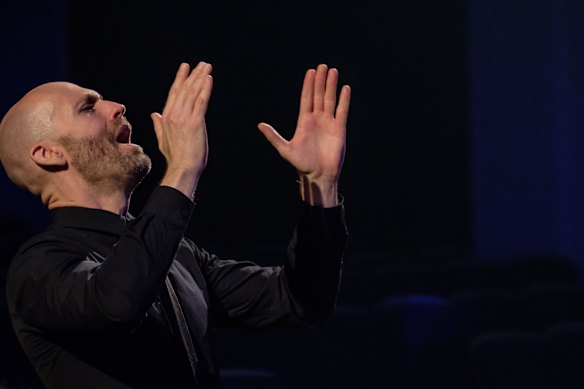
Forte-pianist Erin Helyard.Credit: Robert Catto
A notable feature of Boud and Helyard’s performance was clarity of balance. Boud’s tone glowed warmly, the low notes of the fortepiano were crisp and the upper register sang with translucent lightness. Neither instrument overwhelmed the other, as can happen when this work is played on a modern piano and French horn.
After a bright hunting call opening and brilliant passage work, the second theme suddenly turns to darker introspection (Beethoven marked it calando – “dying away”). Boud drew the tempo and tone back hauntingly and Helyard tapered it further almost to nothing.
By 1800 Beethoven had started to notice hearing problems but hadn’t told anyone. Was he imagining a world without sound? Whatever the case in that work it certainly wasn’t evident in the imaginative treatment he gave to a theme by Mozart in the program’s next work, 12 Variations on Ein Madchen oder Weibchen from The Magic Flute (1796), which Cobcroft and Helyard played with discreet liveliness.
To end the first half, Mozart’s Trio in E flat major, K. 498, (the so-called Kegelstatt or “bowling alley” trio apparently alluding to Mozart’s fondness for mixing composing and bowling) brought the three players together, and they handed around the ornamented main theme of the first movement to create an intimately conversational performance of genial musicality.
Intimate good humour was also a feature of the Aria con Variazioni from Beethoven’s Three Duos WoO 27, played here on cello (rather than bassoon) and clarinet. An amused murmur of recognition spread around the hall as Helyard, after explaining the distinctive features of the eighteenth century fortepiano (in this case a modern copy by Paul McNulty of a Viennese fortepiano by Anton Walter), began Mozart’s Piano Sonata in C, K. 545.
Mozart wrote this for a student and it is still often heard in the lounge rooms of precocious pianophiles. Helyard phrased the lines with deft sophistication, adding ornamental improvisation to repeated sections with unpretentious elegance.
The themes of Beethoven’s Piano Trio in B flat, Opus 11 were more assertively energised than in the Mozart trio earlier, in keeping with the composers’ different personalities, but the performance retained the same pellucid texture and intimacy, allowing one to hear every detail as Beethoven would have done – for a while.
THEATRE
1984
Riverside Theatre, July 25
Reviewed by JOHN SHAND
★★★★½
This is the one that’s worth watching – while Big Brother watches you. A 2017 version at Roslyn Packer Theatre and the 2014 iteration of this Shake & Stir Theatre Co production both did scant justice to George Orwell’s masterpiece. Now Shake & Stir’s director Michael Futcher has hit upon a cast that brings Nelle Lee and Nick Skubij’s adaptation to chilling life.
Scarily, 1984 becomes more relevant with each passing year. Who’d have thought “fake news” would now so closely mirror the Orwellian concept of “doublethink”? Meanwhile, we continue to watch rogue nations embodying Orwell’s idea that power is not a means; it’s an end.
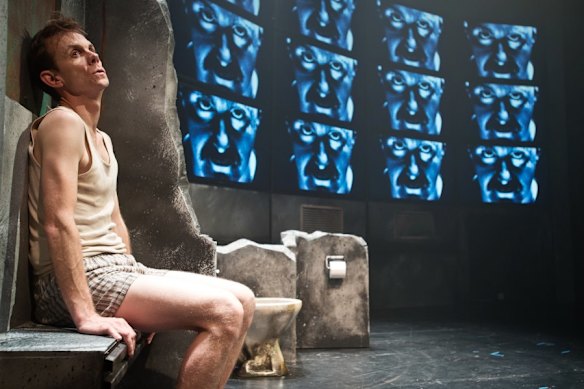
Michael Whalley gives us a Winston with the cunning and bravery to flout the rules.Credit:
Josh Macintosh’s set, a bleak, grey amalgam of industrial landscape and subterranean ruin, admirably serves as Winston Smith’s flat, workplace and torture chamber. The room above Charrington’s antique shop – Winston and Julia’s love nest – ingeniously opens upon the stage from a side wall, and Orwell’s all-seeing, all-pervasive telescreens are rendered in a giant screen showing videos devised by Craig Wilkinson.
But Orwell was not writing science fiction, and the most imaginative visuals in the world will not bring the book to life. That requires a brilliant script to render 350 pages down to 100 minutes without losing any essences (which Lee and Skubij have done), and compelling actors playing Winston, Julia and O’Brien (the Inner Party kingpin).
Michael Whalley is supremely convincing as Winston. He not only encapsulates the intelligence (that makes O’Brien take interest), nerdiness and loneliness, but makes real the poetic longing for a fabled world that preceded Big Brother’s rule. Whalley gives us a Winston with the cunning and bravery to flout the rules, and one capable of returning Julia’s passion.
Chloe Bayliss excels as Julia. She makes it credible that Julia can play-act perfectly in the daily Two Minutes Hate, hurling invective at the telescreen, and yet delight in sex for sex’s sake, and fall madly and unquestioningly in love. Although a role with less scope than Whalley’s, Bayliss pours herself into it to the brim.
I always imagined Charles Dance would have made an admirable O’Brien, with his authoritative voice and ability to meld elegance and iciness, and here Tony Cogin hits upon exactly those qualities. Cruelty is so much more chilling when the perpetrator is vocally restrained and highly civilised, and Cogin is the suave and brutal incarnation of Big Brother’s right-hand man.
The cast is completed by Abhilash Kaimal (who’s good as Syme, less so as Charrington) and Steven Rooke, who superbly depicts poor Parsons, the numbskull busybody who’s denounced for “thoughtcrime” by his little daughter.
One weak link is the mimed workplace typing scene, which could be tightened, but the torture scenes are so strong they’re hard to take, and the gentleman beside me seemed to wonder what he’d done wrong to have to sit through it all. Nothing. It’s the innocents who are most endangered by creeping totalitarianism.
MUSIC
The Hives
Enmore Theatre, July 23
Reviewed by JAMES JENNINGS
★★★★
There are bands that play their songs live, and there are bands that put on a show. Sweden’s the Hives belong firmly in the second category. They are a group that lean hard into the theatricality and absurdity – but most importantly, the fun – of playing loud songs in a rock’n’roll band.
From the country-and-western-style matching black-and-white suits to their stage names – vocalist Howlin’ Pelle Almqvist, lead guitarist Nicholaus Arson, rhythm guitarist Vigilante Carlstroem, bassist The Johan and Only and drummer Chris Dangerous – it’s clear the Hives don’t take themselves terribly seriously (see also: two stagehands dressed as ninjas, one who plays the tambourine throughout).
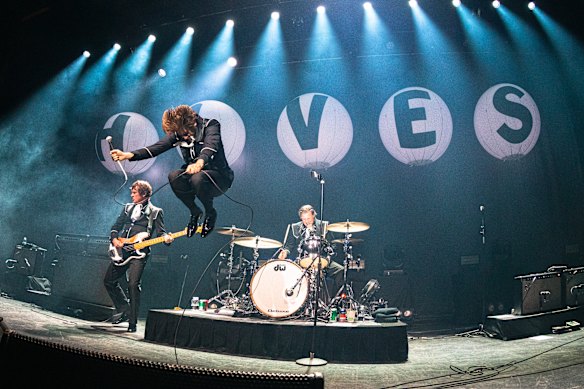
The Hives don’t just play – they put on a show. Credit: Richard Clifford
What they do take seriously is whipping the crowd into a frenzied pack of devout rock’n’roll worshippers, all achieved via a killer live show and a livewire frontman.
Addressing the audience like a feverish preacher from middle America is Almqvist, who wastes no time in showing off his mastery of the genre’s tropes – spinning microphones, high kicks and shouting the kind of hyperbolic boasts that would make the Gallagher brothers blush (“Doesn’t it feel good to be in the presence of the Hives?”).

Clearly, the Hives don’t take themselves terribly seriously. Credit: Rick Clifford
None of it would work without the songs to back up the bold presentation, but the Hives have more than enough belters from across their near-three-decade career to warrant the chest beating. Main Offender and Hate to Say I Told You So, the singles that put the Hives on the map in the early Noughties, sound just as electric 25 years on, the latter a highlight when a young fan is invited on stage to play bass, and nails it.
A return to the stage for an encore is introduced with more self-referential humour (“Surprise! Who knew? Us!” says a wild-eyed Almqvist), with the final song, Tick Tick Boom, the perfect encapsulation of what makes the Hives great: endlessly listenable primal rock tunes designed for the simple purpose of getting hips to shake (“It’s not rocket surgery,” Almqvist observes).
“Do you wanna hear some rock’n’roll?” Almqvist asks earlier in the show. “We are well equipped, and we’re f---ing good at it.”
It’s no idle boast, and saying it has felt good to be in the presence of the Hives is an understatement. As the band walk off to Carly Simon’s Nobody Does It Better, it’s hard to disagree.
THEATRE
Emerald City
Ensemble Theatre, July 23
Until August 23
Reviewed by CASSIE TONGUE
★★★
At the opening of the Ensemble Theatre’s new production of David Williamson’s classic play Emerald City, vibrant Ken Done illustrations of a sparkling Sydney Harbour appear in a filmstrip frame on the back wall of Dan Potra’s set. It’s art as time machine: we’re heading back to 1987.
We meet Colin (Tom O’Sullivan), a screenwriter who moves from Melbourne to Sydney at the urging of his producer (Danielle Carter) to step up his career. His wife, Kate (Rachel Gordon), is reluctant to make the move; she’s convinced Sydney is all style and no substance.

Aisha Aidara as Helen. Credit: Phil Erbacher
But Sydney will win you over. Charmed by the water, the jacarandas and the flame trees, and flattered by climbers at cocktail parties, Colin finds himself compromising his values of making meaningful Australian stories to play at constructing commercial successes for the American market with no local accents in sight.
Mike McCord (Matt Minto) is the “harlot” who seduces Colin over to this dark side, a network-building soap opera script editor with a hunger for fame. What will happen to Colin’s integrity? Will Kate also resist the siren call of status and success in her publishing world? Will their marriage weather their warring minds and careers? And will Colin, in his hunger for more, ignore his attraction to Mike’s partner, Helen (Aisha Aidara)?
Williamson’s play has plenty to say about Sydney that’s still relevant today, making plenty of on-point jokes about the city’s glittery image-consciousness, private-school social networks and obsession with climbing the property ladder.
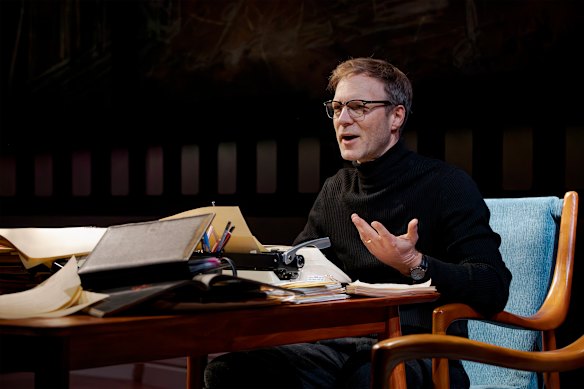
Tom O’Sullivan as screenwriter Colin. Credit: Phil Erbacher
But it’s a social satire that’s also deeply concerned with how little – culturally and institutionally – we value Australian stories. This is still a going concern: more than 30 years from this play’s inception, Screen Australia’s latest drama report shows already conservative spending on local film and TV has fallen by almost 30 per cent.
Sharing our stories helps us build a better sense of who we are and who we can be, and this play is horrified – on paper and on stage – that we still cede so much screen time to Hollywood. Director Mark Kilmurry has taken that message to heart, and has Colin deliver the play’s most sincere lines about Australian storytelling direct to the audience.
These pleas come at a sacrifice: the production’s heart is in the right place, Potra’s costumes enjoyably period, but the play’s humour wilts in the presence of such blunted and didactic scene-building.
The play feels creaky, too. The actors are clearly still developing their performances, with stumbled lines and wooden choices that feel more rote than felt. There are also some decades-old playwriting sensibilities, like the play’s direct and establishing first scene, and old ideas about gender and relationships, that feel less effective now. And Williamson’s characters, in their winking asides to the audience, don’t feel as fun as they could – though Carter and Minto have some pleasing sparkiness to their Sydneysider personalities.
For a play about a vibrant city bursting with stories, this one feels relatively staid. Let’s hope it loosens up over the course of its run.